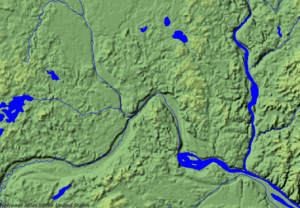River Warren


River Warren (English also Glacial River Warren ) was a prehistoric glacial stream that drained the Agassiz Sea in central North America between 11,700 and 9,400 years ago. The enormous amount of water that emerged from the lake created a mighty valley that is now traversed by the much smaller Minnesota River and the upper reaches of the Mississippi River .
Lake Agassiz was formed by the meltwater of the Laurentide Ice Sheet when the ice sheet prevented the water from flowing north during the Wisconsin glaciation of the last cold period . The Agassiz was a large body of water, about 200 meters deep, and at various times it covered an area of 300,000 square kilometers. The water level rose until about 11,700 years ago when it finally overcame the Big Stone Moraine created by the retreating glaciation. At Browns Valley , Minnesota, the draining water, the discharge of which took on catastrophic proportions, cut a gorge through the moraine that is about 1.6 kilometers wide and 40 meters deep and is now known as the Traverse Gap .
Here the glacial River Warren began. From its formation to the complete drying up of the southern outflow of Lake Agassiz, the meltwater of the Laurentide Ice Sheet flowed through the Traverse Gap into the Mississippi valley. However, this did not happen continuously, but rather the advancing and retreating of the ice sheet and its ice thickness during different climatic phases resulted in isostatic changes in the land level, which in turn enabled or blocked other outflows from the lake to the sea.
During its existence, the glacial stream cut into the landscape and eroded a valley up to 8 kilometers wide and 80 meters deep. This valley begins at the Traverse Gap near Browns Valley, Minnesota, runs southwest to Mankato and then turns northeast to the Twin Cities , where the relatively smaller Mississippi River flows into the glacial stream. River Warren undercut the smaller river at the site of Fort Snelling , creating waterfalls that have since migrated up the Mississippi through regressive erosion and now form Minnehaha Falls and Saint Anthony Falls in Minneapolis . From Fort Snelling the valley continues northeast to today's Saint Paul and then turns southeast towards Prescott , where the St. Croix River flows, which itself was once an outflow from another Ice Age lake, Lake Duluth in the western part of today's Upper Lake . From its confluence with the St. Croix, the valley runs to the southeast, where today the borders between Minnesota and Wisconsin lie. River Warren caused the formation of cliff-like bank sections in the valleys of Minnesota and Mississippi and contributed to the formation of Lake Pepin .
About 9400 years ago the ice sheet retreated so far that Lake Agassiz could permanently take another drain and sank below the level of the Traverse Gap. River Warren dried up. The catchment area of Lake Agassiz now feeds the Red River of the North , which flows north and finally flows into Hudson Bay . The upper valley of the River Warren in the Traverse Gap now flows through the Little Minnesota River , which flows into Big Stone Lake , and the Minnesota River, which follows the former glacial valley to its confluence with the Mississippi. Both streams occupy only part of the former bed of the River Warren.
Naming
The hydrology of the oversized valleys was first declared in 1868 by Governor General Kemble Warren . He explored the region in search of a possible route for the transcontinental railroad. After his death, the prehistoric river was named River Warren in his honor.
Individual evidence
- ↑ Lusardi, Quaternary Glacial Geology , pp. 3-4; Sansome, Minnesota Underfoot , 175.
- ^ Fisher, River Warren Boulders , pp. 348,350
- ↑ Sansome, Minnesota Underfoot , pp. 174 f .; Upham, The Glacial Lake Agassiz , pp. 14-17
- ^ Fisher, River Warren Boulders , 351
- ↑ Sansome, Minnesota Underfoot , pages 118-119
- ↑ Ojakangas, Minnesota's Geology , pp. 110-114
- ↑ Fisher, River Warren boulders , p 350
- ↑ MRBDC, Valley Formation
- ^ Governor Kemble Warren Papers, 1848–1882
- ↑ Upham, The Glacial Lake Agassiz ( Memento of the original from April 29, 2007 in the Internet Archive ) Info: The archive link was inserted automatically and has not yet been checked. Please check the original and archive link according to the instructions and then remove this notice. , Pp. 7-8.
literature
- Timothy G. Fisher: River Warren boulders, Minnesota, USA: catastrophic paleoflowindicators in the southern spillway of glacial Lake Agassiz (PDF; 2.8 MB). In: Boreas. 33, 4, 2004, ISSN 0300-9483 . Pp. 349-358 doi : 10.1111 / j.1502-3885.2004.tb01245.x .
- Richard W. Ojakangas, Charles L. Matsch: Minnesota's Geology. University of Minnesota Press, Minneapolis 1982, ISBN 0-8166-0953-5 .
- Constance Jefferson Sansome: Minnesota Underfoot: A Field Guide to Minnesota's Geology. Voyageur Press, Stillwater, MN 1983, ISBN 0-8965-8036-9 .
- Warren Upham: The Glacial Lake Agassiz. In: Monographs of the United States Geological Survey XXV, 1896/2002. Retrieved May 14, 2007.
Web links
- Minnesota River Basin Data Center (MRBDC): Minnesota River Valley Formation . Fact sheets . Minnesota State University, Mankato 2004. Retrieved May 14, 2007.